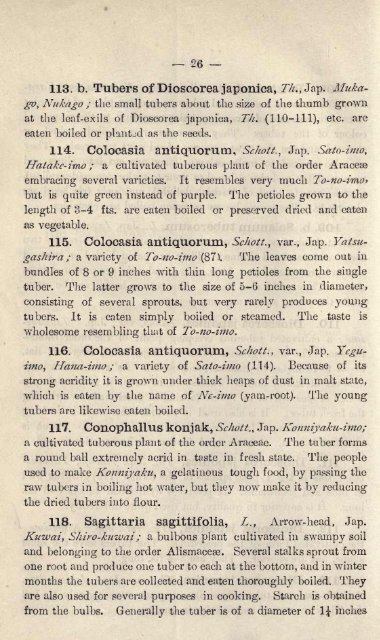Untitled - University of Oregon
Untitled - University of Oregon
Untitled - University of Oregon
Create successful ePaper yourself
Turn your PDF publications into a flip-book with our unique Google optimized e-Paper software.
113. b. Tubers <strong>of</strong> Dioscorea japonica, 77;., Jap. Muka-<br />
go, Niikago ; the small tubers about the size <strong>of</strong> the thumb grown<br />
at the leaf-exils <strong>of</strong> Dioscorea japonica, T/i. (110-111), etc. are<br />
eaten boiled or plantjd as the seeds.<br />
114. Colocasia antiquorum, Schott., Jap. Sato-imo,<br />
Hatake-imo ; a cultivated tuberous plant <strong>of</strong> the order Araceae<br />
embracing several varieties. It resembles very much To-no-imo*<br />
but is quite green instead <strong>of</strong> purple. The petioles grown to the<br />
length <strong>of</strong> 3-4 fts. are eaten boiled or as vegetable.<br />
preserved dried and eaten<br />
115. Colocasia antiquorum, Schott., var., Jap. Yatsu-<br />
gashira ; a variety <strong>of</strong> To-no-imo (871 The leaves come out in<br />
bundles <strong>of</strong> 8 or 9 inches with thin long petioles from the single<br />
tuber. The latter grows to the size <strong>of</strong> 5-6 inches in diameter,<br />
consisting <strong>of</strong> several sprouts, but very rarely produces young<br />
tubers. It is eaten simply boiled or steamed. The taste is<br />
wholesome resembling that <strong>of</strong> To-no-imo.<br />
116. Colocasia antiquorum, Schott., var., Jap. Yegu-<br />
imo, Hana-imo ; a variety <strong>of</strong> Sato-iino (114). Because <strong>of</strong> its<br />
strong acridity it is grown under thick heaps <strong>of</strong> dust in rnalt state,<br />
which is eaten by the name <strong>of</strong> Ne-imo (yam-root). The young<br />
tubers are likewise eaten boiled.<br />
117. Conophallus konjak, Schott., Jap. Konniyaku-imo;<br />
a cultivated tuberous plant <strong>of</strong> the order Araceae. The tuber forms<br />
a round ball extremely acrid in taste in fresh state. The people<br />
used to make Konniyaku, a gelatinous tough food, by passing the<br />
raw tubers in boiling hot water, but they now make it by reducing<br />
the dried tubers into flour.<br />
118. Sagittaria sagittifolia, L., Arrow- head, Jap.<br />
Kuwai, Sliiro-kuwai ; a bulbous plant cultivated in swampy soil<br />
and belonging to the order Alismaceae. Several stalks sprout from<br />
one root and produce one tuber to each at the bottom, and in winter<br />
months the tubers are collected and eaten thoroughly boiled. They<br />
are also used for several purposes in cooking. Starch is obtained<br />
from the bulbs. Generally the tuber is <strong>of</strong> a diameter <strong>of</strong> 1J inches

















